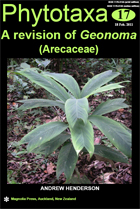| Phytotaxa ISSN 1179-3155 (print); ISSN 1179-3163 (online) | |
|
A rapid international journal for accelerating the publication of botanical taxonomy |
| Phytotaxa ISSN 1179-3155 (print); ISSN 1179-3163 (online) | |
|
A rapid international journal for accelerating the publication of botanical taxonomy |
|
0Home | Online content | Editor | Information for authors | How to order0 |
|||||||||||||||||

Buy
a copy of this volume |
Phytotaxa
17: 1–271
(18 Feb. 2011)
Monograph Abstract A taxonomic revision and phylogeny of the neotropical palm genus Geonoma based on morphological data and morphometric methods was carried out. 4990 herbarium specimens were scored for 44 qualitative variables and 27 quantitative variables. Qualitative variables were divided into 30 characters and 14 traits. Using the phylogenetic species concept, characters were used to recognize 68 species. These are widely distributed from southern Mexico to Bolivia and Paraguay, and reach the Lesser Antilles and Hispaniola. Analysis of each species for traits, geographic distribution, and quantitative variables led to recognition of 90 subspecies in 18 species, giving a total of 140 taxa. Twelve new species (G. bernalii, G. concinnoidea, G. deneversii, G. dindoensis, G. fosteri, G. galeanoae, G. gentryi, G. operculata, G. peruviana, G. sanmartinensis, G. schizocarpa, G. venosa) and 33 new subspecies (G. brongniartii subsp. pascoensis, G. concinna subsp. simplex, G. concinnoidea subsp. coclensis, G. concinnoidea subsp. jefensis, G. congesta subsp. osensis, G. cuneata subsp. guanacastensis, G. cuneata subsp. indivisa, G. cuneata subsp. minor, G. cuneata subsp. rubra, G. deversa subsp. belizenesis, G. deversa subsp. peninsularis, G. deversa subsp. quadriflora, G. ferruginea subsp. nicaraguensis, G. lehmannii subsp. corrugata, G. longivaginata subsp. copensis, G. longivaginata subsp. sanblasensis, G. longivaginata subsp. vallensis, G. maxima subsp. dispersa, G. maxima subsp. multiramosa, G. maxima subsp. sigmoidea, G. pohliana subsp. linharenseis, G. pohliana subsp. rodriguesii, G. pohliana subsp. unaensis, G. stricta subsp. antioquiensis, G. stricta subsp. bracteata, G. stricta subsp. divaricata, G. stricta subsp. pendula, G. stricta subsp. pliniana, G. stricta subsp. quibdoensis, G. stricta subsp. submontana, G. undata subsp. tacarcunensis, G. undata subsp. tumucensis, G. undata subsp. venezuelana) are described. Forty-one new combinations are made. Several of the most variable species are considered to be species complexes and are divided into morphotypes—groups of similar specimens with no formal taxonomic status. Nomenclature, descriptions and distribution maps are provided for each species and subspecies. Images of the type specimens of all new taxa are also provided. A phylogenetic analysis, using the same 30 characters used for the taxonomic revision was carried out using parsimony analysis. A sample tree and consensus tree are shown and a discussion is given of the various clades.Key words : Palmae, palms, phylogeny, morphometrics, Neotropics |
|
|||||||||||||||
| Copyright © 2011 Magnolia Press | Published : 18 Feb. 2011 |